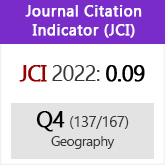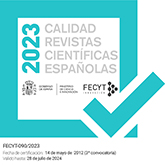Polarization of the functional structure of capital cities of provinces and autonomies in Spain: 1981-2011
DOI:
https://doi.org/10.3989/estgeogr.201404Keywords:
specialization, concentration, innovation, capital, SpainAbstract
Some fundamental trends of the recent reorganization of economic activities in Spain are defined by the growing concentration in certain urban areas of certain economic activities, especially those related to the creation, management and use of innovation and knowledge, and selective decentralization of others. The main hypothesis of this work assumes that capital of autonomy is a factor that exerts some influence on the structure of economic activities in a city. In this paper we study the scope of this thesis referred to municipalities and provincial capitals of autonomy between 1981 and 2011. The study conducted helps verify the trend towards concentration of capital in certain activities of the knowledge economy. The good connectivity of cities or the proximity to large urban areas are attractive forces; the capital of autonomy has a limited influence on intermediate sized nuclei located in dynamic regional contexts.
Downloads
References
Acs, Z. J. (ed.) (2006): The growth of cities. Cheltenham, Edward Elgar.
Bailly, A. S. y Coffey, W. J. (1994): "Localisation des services à la production et resturations économiques. Un analyse théorique". L'Espace Géographique, 1, pp. 224-230. http://dx.doi.org/10.3406/spgeo.1994.3309
Barcet, A., Bonamy, J. y Mayere, A. (1984): "Les services aux entreprises: problèmes théoriques et méthodologiques". Recherches économiques et sociales. La documentation française, 9, pp. 254-277.
Castells, M. (1995): La ciudad informacional. Tecnologías de la información, reestructuración económica y el proceso urbano regional. Madrid, Alianza Editorial.
Clayton, N. y Morris, K. (2010): Recession, Recovery and Medium-Sized Cities. Londres, 40 p. Disponible en: http://www.theworkfoundation.com/ (Consultada en febrero de 2014).
Coats, D. (2005): "An agenda for work: The Work Foundation's challenge to policy makers". The Work Foundation, 1/2, p. 57. Disponible en: http://www.theworkfoundation.com/assets/docs/publications/73_Agenda_for_work.pdf (Consultada en febrero de 2014).
Coats, D. y Lekhi, R. (2008): "'Good Work': Job Quality in a Changing Economy". The Work Foundation, 89. Disponible en http://www.theworkfoundation.com/ (Consultada en febrero de 2014).
Cooke, P.; Asheim, B.; Boschma, R. et al. (eds.) (2011): Handbook of Regional Innovation and Growth. Cheltenham, Edward Elgar Publishing. http://dx.doi.org/10.4337/9780857931504
Cuadrado, J. y Maroto, A. (2012): "Análisis del proceso de especialización regional en servicios en España". EURE, 38/114, pp. 5-34. http://dx.doi.org/10.4067/S0250-71612012000200001
Drucker, P. F. (1969): The age of discontinuity: guidelines to our changing society. London, Heinemann.
Duranton, G. y Puga, D. (2002): From Sectoral to Functional Urban Specialization. London, Centre for Economic Policy Research (CEPR). Discussion. Paper, 2971, revised version June 2003.
Escolano, S. (2012): "Efectos de la capitalidad autonómica en la dinámica del sistema urbano español", en Valenzuela, M. (coord.), El impacto del modelo autonómico en las ciudades españolas. Una aproximación interdisciplinar. Madrid, Servicio de Publicaciones de la Universidad Autónoma de Madrid, pp. 145-170.
EUROSTAT (2011): Science, technology and innovation in Europe. Luxemburgo, Comisión Europea, EUROSTAT.
EUROSTAT (s/f): Aggregations of manufacturing based on NACE Rev 1.1. EUROSTAT: 2. Disponible en: http://epp.eurostat.ec.europa.eu/cache/ITY_SDDS/Annexes/htec_esms_an2.pdf (Consultada en febrero de 2014).
Glazer, L. y Grimes, D. (2009): Michigan's Transition to a Knowledge-Based Economy: Second annual Progress Report. Michigan, Future. Disponible en: http://www.michiganfuture.org/Reports/progress%20report%2009.pdf (Consultada en febrero de 2014).
Halbert, L. (2005): "Les métropoles, moteurs de la dématérialisation du système productif urbain français: une lecture sectorielle et fonctionelle (1982-1999)". Bulletin de l'Association de Géographes Françaises, 3, pp. 279-297. http://dx.doi.org/10.3406/bagf.2005.2463
Hepworth, M. (1986): "The Geography of Technological Change in the Information Economy". Regionalo Studies, 20/5, pp. 407-424. http://dx.doi.org/10.1080/09595238600185361
INE (s/f): CNAE-93 Rev 1: Clasificación nacional de Actividdes Económicas. 1993 Rev.1. INE: 32. Disponible en: http://www.ine.es/clasifi/cnae93rev1.pdf (Consultada en febrero de 2014).
Instituto Geográfico Nacional (2008): Atlas Nacional de España: Demografía. Madrid, Centro Nacional de Información Geográfica.
Jonhston, R. J.; Taylor, P. J. y Watts, M., (eds.) (2002): Geographies of global change: remapping the world (2nd). Oxford, Blackwell.
Korres, G. M. (2009): Technical change and economic growth: Inside the knowledge based Economy 2008. London, Averbury Press.
Korres, G. M.; Tsobanaglou, G. O. y Kokkinou, A. (2011): "Innovation Geography and Regional Growth in European Union". SageOPen, 1-10, DOI:10.1177/2158244011413142. Disponible en: http://sgo.sagepub.com/con tent/1/1/2158244011413142 (Consultada en febrero de 2014). http://dx.doi.org/10.1177/2158244011413142
Krätke, S. (2007): "Metropilisation of the european Economic Territory as a consequence of Increasing Specialisation of Urban Agglomerations in the Knowledge Economy". European Planning Studies, 15/1, pp. 1-27. http://dx.doi.org/10.1080/09654310601016424
López, A. (2011): "¿Vuelve el Centro? Caracterización demográfica de los procesos de reurbanización en las metrópolis españolas", en Pujadas, I.; Bayona, J.; García, A.; et al. (eds.): Población y espacios urbanos . Barcelona, Department de Geografia Human de la UB y Grupo de población de la AGE, pp. 163-180. Disponible en http://www.ub.edu/congreso_poblacion/ (Consultada en febrero de 2014).
Mandeville, T. (1983): "The Spatial Effects of Informational Technology". Futures, 15/1, pp. 65-72. http://dx.doi.org/10.1016/0016-3287(83)90073-3
May, N. (1997): "From territorial production systems to metropolitanization: ten years of research in France", en Moulaert, F. y Scott, A. J. (eds.): Cities, enterprises and society on the eve of 21st century. London, Pinter, pp. 57-77.
Méndez, R.; Michelini, J. J.; Prada, J.; et al. (2012): "Economía creativa y desarrollo urbano en España: una aproximación a sus lógicas espaciales". EURE, 38/113, pp. 5-32. http://dx.doi.org/10.4067/S0250-71612012000100001
Méndez, R. y Pascual, H. (eds.) (2006): Industria y ciudad en España: nuevas realidades, nuevos retos. Cizur Menor (Navarra), Aranzadi, Thomsom-Civitas.
Méndez, R.; Sánchez, S.; Abad, L.; et al. (2009): "Sistema urbano y sociedad del conocimiento: hacia una tipología de las ciudades españolas". Investigaciones Regionales, 16, pp. 117-142.
Mitchell, W. J. (1995): City of bits : space, place, and the infobahn. Cambridge, Massachusetts, MIT.
Moreno, A. y Escolano, S. (1992): Los servicios y el territorio. Madrid, Síntesis.
Mos, M. (1998): "Technology and Cities". Cityscape: A Journal of Policy Development and Research, 3/3, pp. 107-127.
Moulaert, F. y Scott, A. J. (1997): "Globalization, economic reestructuring and urban society", en Moulaert, F. y Scott, A. J. (eds.): Cities, enterprises and society on the eve of 21st century. London, Pinter, pp. 3-17.
Puissant, S. y Lacour, C. (2011): "Mid-sized French cities and their niche competitiveness". Cities, 28, pp. 433-443. http://dx.doi.org/10.1016/j.cities.2011.05.008
Reques, P. (2011): "Transformaciones espaciales y procesos socio-demográficos en la ciudad", en Pujadas, I., Bayona, J., García, A., et al. (eds.): Población y espacios urbanos. Barcelona, Department de Geografia Human de la UB y Grupo de población de la AGE, pp. 235-284. Disponible en: http://www.ub.edu/congreso_poblacion/ (Consultada en febrero de 2014).
Reques, P. y Rodríguez, V. (1998): Atlas de la población española. análisis de base municipal. Santander, Servicio de Publicaciones de la Universidad de Cantabria/CSIC/ESRI-España.
Scott, A. J. (1997): "The cultural economy of cities". International Journal of Urban and Regional Research, 21/2, pp. 323-339. http://dx.doi.org/10.1111/1468-2427.00075
Stehr, N. (1994): Knowledge Societies: The Transformation of Labour, Property and Knowledge in Contemporary society. London, Sage.
Storper, M. y Venables, A. J. (2004): "Buzz: face-to-face contact and the urban economy". Journal of The Economic Geography, 4, pp. 351-370. http://dx.doi.org/10.1093/jnlecg/lbh027
UNESCO (2005): Towards Knowledge Societies. Paris, UNESCO.
Ureña, J. M. D. (ed.) (2012): Teritorial Implications of High Speed Rail. A Spanish Perspective. Farnham (UK), Ashgate.
Ureña, J. M. D.; Coronado, J. M.; Garmendia, M.; et al. (2012): "Terrotorial Implications at national and Regional Scales of High-sèed Rail", en Ureña, J. M. D. (ed.): Terrotorial Implications of High Speed Rail. A Spanish perspective. Farnham (UK), Asghate, pp. 129-162.
Varga, A. (ed.) (2009): Universities, Knowledge Transfer and Regional Development. Geography, Entrepreneurship and Policy . Cheltenham, Inglaterra, Edward Elgar Publising.
Veltz, P. (1997): "The dinamics of production systems, territories and cities", en Moulaert, F. y Scott, A. J. (eds.): Cities, enterprises and society on the eve of 21st century. London, Pinter, pp. 78-96.
Yigitcanlar, T. (2009): "Spatial reestructuring of cities in the age of knowledge economy: insights from Australian cities", en 2nd Knowledge Cities Summit. Shenzhen, China, QUT Digital Repository.
Downloads
Published
How to Cite
Issue
Section
License
Copyright (c) 2014 Consejo Superior de Investigaciones Científicas (CSIC)

This work is licensed under a Creative Commons Attribution 4.0 International License.
© CSIC. Manuscripts published in both the printed and online versions of this Journal are the property of Consejo Superior de Investigaciones Científicas, and quoting this source is a requirement for any partial or full reproduction.All contents of this electronic edition, except where otherwise noted, are distributed under a “Creative Commons Attribution 4.0 International” (CC BY 4.0) License. You may read here the basic information and the legal text of the license. The indication of the CC BY 4.0 License must be expressly stated in this way when necessary.
Self-archiving in repositories, personal webpages or similar, of any version other than the published by the Editor, is not allowed.
















